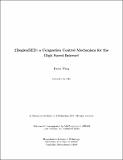2RegionRED: a Congestion Control Mechanism for the High Speed Internet
| dc.contributor.author | Wang, Karen | en_US |
| dc.date.accessioned | 2023-03-29T15:34:42Z | |
| dc.date.available | 2023-03-29T15:34:42Z | |
| dc.date.issued | 2001-12 | |
| dc.identifier.uri | https://hdl.handle.net/1721.1/149932 | |
| dc.description.abstract | This thesis proposes a new Active Queue Management (AQM) scheme called 2RegionRED. It is superior to the classic Random Early Detection (RED) algorithm in that there is an intuitive way to set its parameters and it is self-tuning. Its design is motivated by an original principle to sustain the smallest queue possible while still allowing for maximum link utilization. 2RegionRED uses the number of competing TCPs as its measure of load. However it does not keep an explicit count. The result is a novel algorithm that adjusts the drop rate according to two regions of operation: that requiring less than and greater than one drop per round-trip time (RTT). This thesis also analyzes methods for measuring the persistent queue and proposes the ABSMIN method. Simulations of 2RegionRED using ABSMIN reveal some difficulties and insights. Basic comparisons to the Adaptive RED and Flow Proportional Queuing (FPQ) adaptive algorithms are also demonstrated through simulation | en_US |
| dc.relation.ispartofseries | MIT-LCS-TR-829 | |
| dc.title | 2RegionRED: a Congestion Control Mechanism for the High Speed Internet | en_US |
